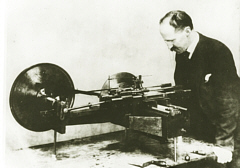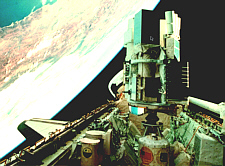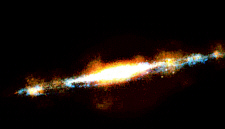
|
|
APRIL 2000 CONTENTS
|
|
PIONEERS GUEST BOOK
|
| A century after Henry Rowland transformed the study of the stars, astronomers continue to rely on the product of his genius. |
|
Opening photo: The Rowland ruling engine produced
exquisitely precise diffraction gratings for
spectroscopy. Photo courtesy Ferdinand Hamburger Jr. Archives |
Pioneers of Discovery
· · · · · · · · · · · ·
Spectral Illuminations
By Melissa Hendricks

Henry A. Rowland, Johns Hopkins University's first physics professor, has been called the finest physicist of his day, a brilliant experimentalist who did seminal work on electricity and magnetism. But Rowland's most noted accomplishment was a feat of engineering involving a screw and an instrument called a ruling engine.
Astronomers in the late 19th century had begun using reflective plates etched with thousands of fine lines to analyze the light from stars. The plates, or diffraction gratings, dispersed the light from the sun or other star into its component colors, or wavelengths. By analyzing a star's spectrum, astronomers could figure out many things about the star, such as its chemical composition and temperature.
When Rowland, at age 27, began his tenure at Hopkins in 1876, spectroscopy had serious limitations. Diffraction gratings were relatively imprecise, yielding spectra that contained ghostlike false signals among the true spectral readings.
The problem, Rowland concluded, was the lead screw in the ruling engines that were used to etch the fine lines on diffraction gratings. The screw moved the grating a small amount after each line was ruled. "But the screws could never be perfect," explains Hopkins astronomer Alan Uomoto, who is a spectroscopist on the Sloan Digital Sky Survey, an ambitious effort to map the stars. During each turn of the screw, the amount the grating moved varied slightly.
Rowland's genius was to engineer a ruling engine containing a screw of nearly flawless pitch. He also used spherically curved plates for his diffraction gratings, where his predecessors had been using flat plates. The result of his innovations was diffraction gratings that produced spectra of superb resolution and accuracy. Today, a Rowland ruling engine is on display at Homewood's Bloomberg Center, home of the Henry A. Rowland Department of Physics and Astronomy.
Rowland used his gratings to produce a map of the spectrum of the sun that was 10 times more accurate than any other. He also began supplying gratings at cost to spectroscopists around the world, and soon his concave gratings were standard issue in labs in Europe and America. To this day, astronomers continue to use Rowland-style gratings.
 |
| Rowland-style gratings were used on the Hopkins Ultraviolet Telescope (above) and the Far Ultraviolet Space Explorer (FUSE), which recently gathered data about the hot gas surrounding the Milky Way. |
Just to name a few: The Hopkins Ultraviolet Telescopes (HUT I and II) contained Rowland diffraction gratings. Designed and built by Hopkins astronomers and engineers, the telescopes flew aboard the space shuttle, gathering spectra in the far ultraviolet portion of the electromagnetic spectrum of hundreds of objects. HUT II detected and measured a primordial gas called the intergalactic medium that is thought to have been created during the Big Bang.
 Likewise, the Far Ultraviolet
Space Explorer, or FUSE, another Hopkins-built and managed
instrument now in space, contains a powerful spectrograph housing
four Rowland gratings. Launched last year, FUSE has yielded a
wealth of findings, including confirmation that a halo of
half-million-degree gas surrounds the Milky Way (pictured above
right) and was formed by the exploding stars known as
supernovae.
Likewise, the Far Ultraviolet
Space Explorer, or FUSE, another Hopkins-built and managed
instrument now in space, contains a powerful spectrograph housing
four Rowland gratings. Launched last year, FUSE has yielded a
wealth of findings, including confirmation that a halo of
half-million-degree gas surrounds the Milky Way (pictured above
right) and was formed by the exploding stars known as
supernovae.
Over the years, astronomers experimented with other types of diffraction gratings. But Henry Rowland was a key pioneer in astronomical spectroscopy, says Uomoto. "His refinements of the technology showed what was possible."
RETURN TO APRIL 2000 TABLE OF CONTENTS.